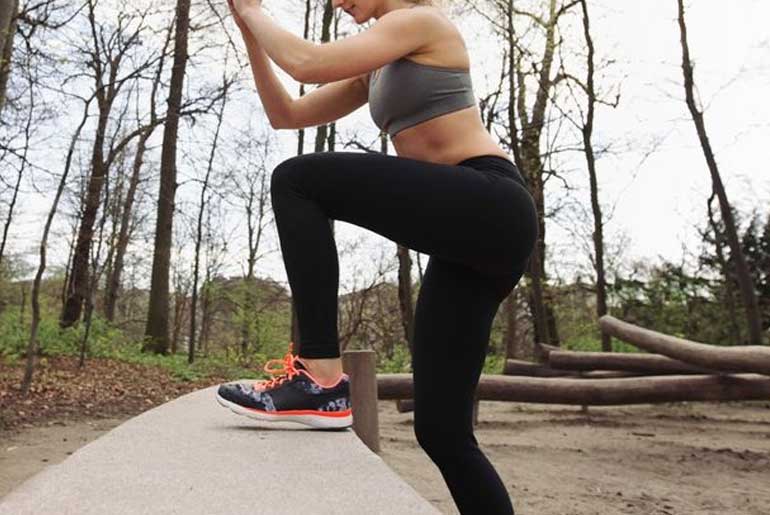If you’re looking to strengthen your butt and legs, step-up exercises are an excellent option. This lower body compound exercise involves stepping onto an elevated surface, such as a box or step, and effectively targets multiple muscle groups, including the glutes, adductors, hamstrings, quadriceps, core, and calves. Step ups also enhance stability and help reduce muscle imbalances by working each leg unilaterally. You can progress in step-ups in two ways: by adding weight or increasing the height of the step. A higher step can provide greater activation of the glutes and hamstrings, making it an effective choice for lower body development.
Benefits of Step Up Exercises
Step ups are an effective bodyweight exercise that primarily targets the muscles in the legs and buttocks. Step ups enhance core strength, stability, and balance. Here are some of the key benefits of incorporating step ups into your workout routine:
Stability and Balance
Regular practice of step-ups significantly improves stability and balance. A study in the Journal of Physical Therapy Science indicates that controlling your weight while stepping up and down enhances balance. This exercise is especially beneficial as it helps prevent falls, which is crucial as we age. Furthermore, step-ups build strength in the legs individually, promoting equal strength development.
Builds Strength
Step-ups effectively increase the strength of various lower body muscles, including the glutes, hamstrings, quadriceps, calves, and core. By strengthening these muscles, step-ups can improve performance in other exercises and daily activities.
Aids Weight Loss
By raising the heart rate, step-ups help burn calories, making them an excellent addition to cardio and resistance training routines. This calorie-burning effect contributes to weight loss and also enhances cardiovascular health.
Strengthens Knees
Step-ups engage all the muscles in the legs, leading to stronger knees. Incorporating weighted step-ups can particularly build strength in the quadriceps, protecting the knees and reducing injury risk, as noted in the Journal of Experimental Orthopaedics.
Versatile and Easy to Do
Step-ups are highly adaptable; you can adjust the height of the step according to your fitness level. This exercise requires minimal equipment—just a step, box, or bench—and can be performed almost anywhere. Step-ups also serve as a low-impact alternative to other strenuous lower body exercises.
Variations of Step-Up Exercises
To keep your workouts engaging, you can explore several variations of the basic step-up exercise:
- Lateral Step-Up: Stand with one foot on a box while the other remains on the ground. Push through the elevated foot to stand on the box.
- Alternating Step-Ups: Step up with one foot, then step back down and repeat with the opposite foot.
- Peterson Step-Up: Stand on the edge of a box, lift your heel, and step down lightly, barely touching the opposite heel to the ground.
- Lateral Step-Ups: Step sideways onto a step, balancing on one leg while the other hovers above the ground.
Side Effects of Step-Up Exercises
While step-ups are generally safe, improper execution or excessive repetition can lead to injuries:
- Back Pain: Incorrect form during step-ups can lead to back pain, particularly with added weights. Those with pre-existing lower back pain should be cautious.
- Overworked Muscles: Overtraining specific muscle groups can lead to injury, emphasizing the importance of including rest and recovery in your routine.
- Knee Problems: Ensure your knees remain stable and do not turn inward or outward during the movement. Prioritize leg stabilization before adding weights.
Common Mistakes to Avoid
To maximize the benefits of step-ups and minimize the risk of injury, be mindful of these common mistakes:
- Knees Passing Toes: Prevent the knee of your active leg from pushing past your toes, as this shifts the muscle engagement and puts stress on the knee joint.
- Rounding Your Back: Keep your back straight and engage your core. If necessary, begin with a lower step to maintain proper form.
- Pushing Up with the Lower Leg: Focus on the leading leg to perform the step-up, treating the trailing leg as dead weight. This maintains the load on the active leg.
Tips for Effective Step-Ups
- Lean forward slightly to engage your glutes and hamstrings.
- Maintain a straight spine and avoid excessive pressure on your lower back.
- Allow at least two days of recovery between leg workouts to facilitate muscle recovery.
Disclaimer:
The information contained in this article is for educational and informational purposes only and is not intended as a health advice. We would ask you to consult a qualified professional or medical expert to gain additional knowledge before you choose to consume any product or perform any exercise.








